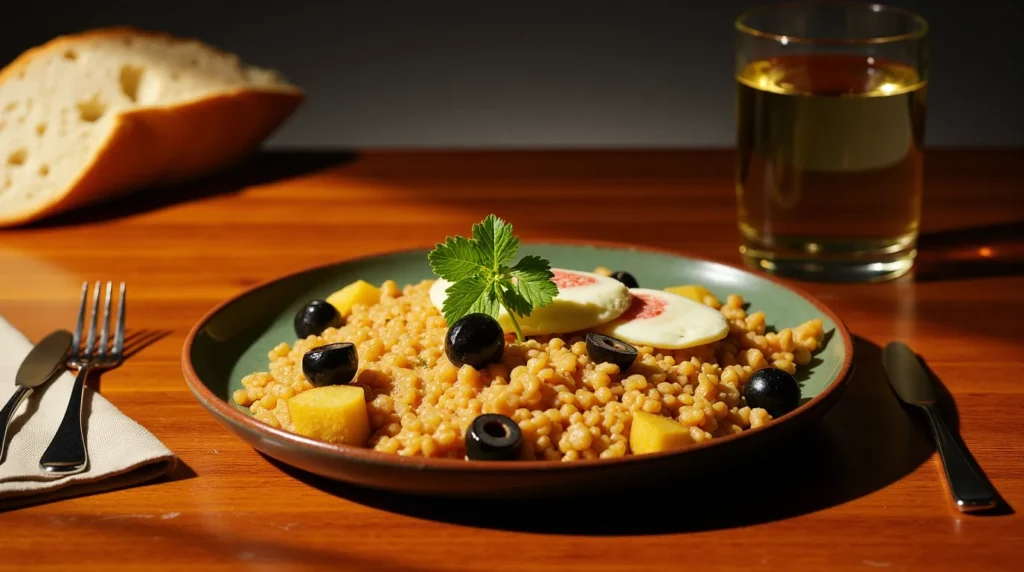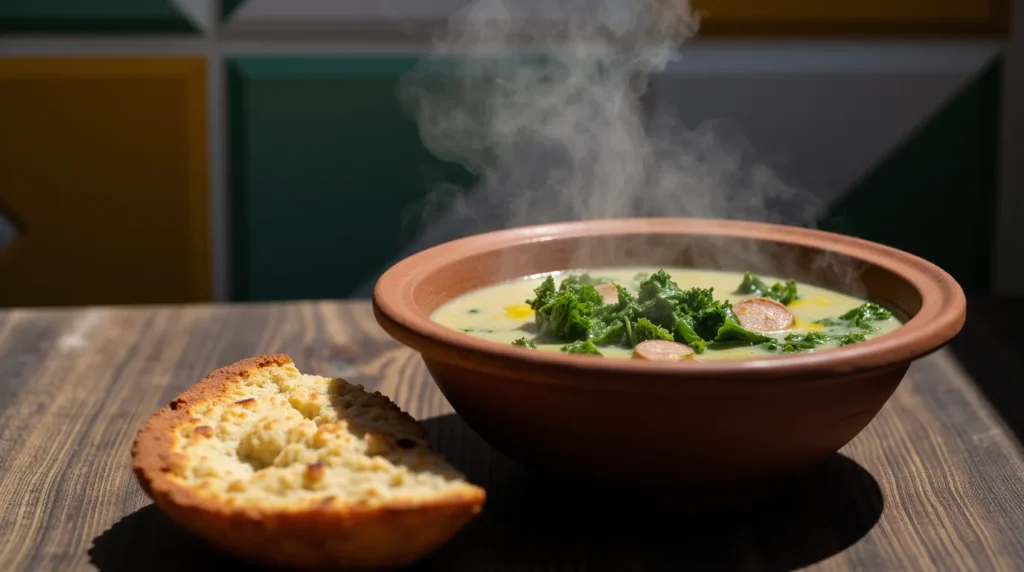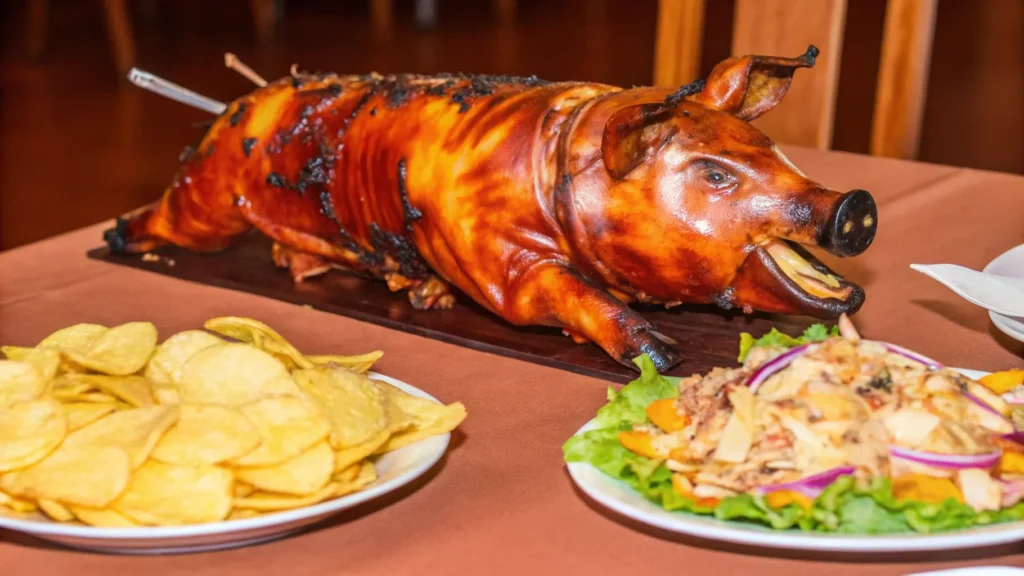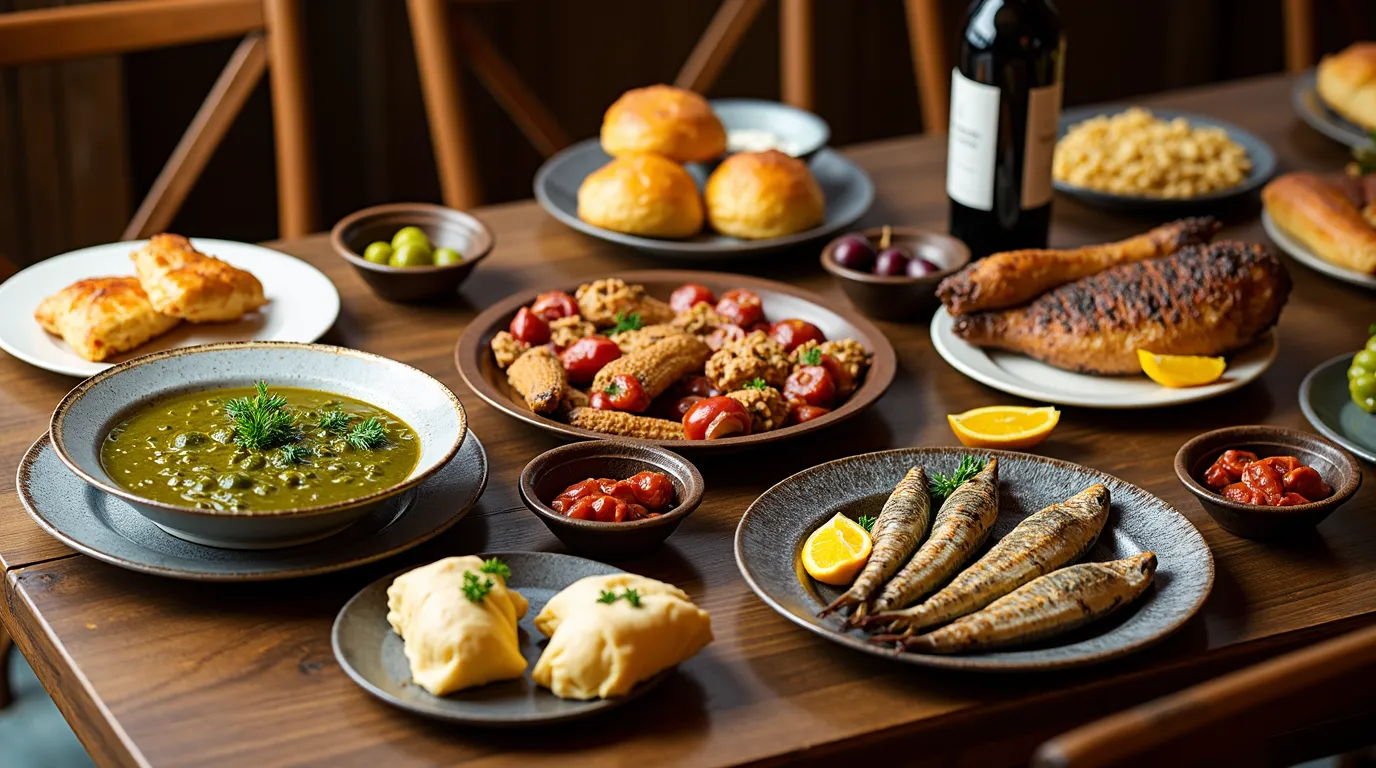Table of Contents
Table of Contents
Introduction
Portuguese cuisine is a vibrant tapestry of flavors and traditions that has delighted food lovers for centuries. Located on the western edge of the Iberian Peninsula, Portugal is blessed with fertile farmland, a long Atlantic coastline, and a rich maritime history. These factors, combined with centuries of cultural exchanges, have shaped a culinary identity that is at once hearty, comforting, and full of surprises. Food in Portugal is about more than nourishment; it is steeped in tradition, social connection, and a deep appreciation for nature’s bounty.
To truly understand Portuguese cuisine, it’s necessary to look at how this country’s food culture has evolved over time. From the spice routes opened during the Age of Discoveries to the modern-day fusion trends, Portugal’s culinary scene has never stopped innovating. Despite these developments, certain elements remain constant, such as the generous use of olive oil, the love for fresh seafood, and the long-standing tradition of bread-making. Each region—from the lush, green north to the sun-baked south—contributes its own distinctive tastes, creating an incredibly diverse, yet unified, gastronomic landscape.
In this article, we will embark on a comprehensive journey through Portugal’s gastronomic heritage. We’ll delve into the culinary context and history of this country, explore key ingredients and local products, highlight must-try dishes, and examine the defining characteristics that make Portuguese cuisine so appealing. We’ll also look at table rituals, customs, and the modern culinary trends shaping the future. By the end, you’ll have a thorough understanding of what makes Portuguese cuisine special—and hopefully, you’ll be inspired to explore it firsthand.
Culinary Context and History
Development Over Time
The roots of Portuguese cuisine stretch back to antiquity, influenced by the Phoenicians, Romans, and Moors who once occupied the Iberian Peninsula. Each group brought with it new foods and cooking methods. The Romans introduced advanced farming techniques, olives, and the production of wine, while the Moors influenced the cultivation of citrus fruits, rice, and almonds. Over the centuries, these external influences were absorbed into local traditions, creating a distinct regional flavor profile that persists to this day.
The major turning point in the evolution of Portuguese gastronomy came with the Age of Discoveries in the 15th and 16th centuries. Portuguese explorers traveled to Africa, Asia, and the Americas in search of new trade routes and resources. They returned with an array of exotic ingredients—such as peppers, chilies, tomatoes, potatoes, and spices like cinnamon and clove—that significantly expanded the flavor palette of Portuguese cooking. It was during this era that iconic dishes began to take shape. Ingredients from the newly discovered lands began to appear in everyday meals, merging with age-old local practices and tastes. The resulting culinary identity was vibrant, varied, and characteristic of a nation that had become a global maritime power.
Historical, Cultural, and Geographical Influences
Geography plays an instrumental role in defining Portuguese cuisine. The country’s long Atlantic coastline not only offers an abundant supply of fresh fish and shellfish but also encourages a tradition of salt production. Indeed, salted cod—bacalhau—would become one of Portugal’s iconic ingredients. Inland, fertile farmlands produce olives, grapes, and a variety of cereals. The mountainous regions in the northern interior are known for hearty sausages, cured hams, and robust stews. Meanwhile, the warm south cultivates citrus fruits, almonds, and a range of Mediterranean vegetables.
Culture, too, has shaped Portugal’s food heritage. Traditional Catholic practices introduced periods of fasting and feasting, leading to a proliferation of fish-based dishes as well as sweet pastries associated with religious holidays. Over time, family gatherings and neighborhood festivals became tied to specific dishes, creating a communal ritual around food. Today, Portuguese cuisine still embodies this sense of community and celebration, whether it’s in a bustling city restaurant or a quiet village tavern.
Key Periods and Events
- Roman Influence: Introduction of winemaking and olive cultivation, setting the stage for Portugal’s love of olive oil and wine.
- Moorish Influence: Cultivation of rice, citrus, and almonds, along with new cooking techniques.
- Age of Discoveries: An explosion of new ingredients, such as peppers, tomatoes, potatoes, sweet potatoes, and spices that transformed Portuguese cooking forever.
- Colonial Exchanges: Ongoing trade and cultural relationships with Brazil, Africa, and parts of Asia reinforced the use of certain spices, as well as the development of sugarcane plantations, which elevated Portuguese pastry-making.
Regional Differences
- North: Known for its lush green landscapes, the north favors hearty dishes like caldo verde (kale soup) and meat stews, often accompanied by robust red wines from the Douro Valley or the vinho verde produced in Minho. The cooler climate allows for an abundance of leafy greens and root vegetables, shaping comforting, warming meals.
- Central Region: The cuisine here balances coastal and inland traditions. You’ll find fish stews in coastal towns, as well as roasted meats and rich sauces in the mountainous interior. Dishes like leitão da Bairrada (roast suckling pig) are celebrated regional specialties.
- Lisbon and Surroundings: Portugal’s capital region boasts a cosmopolitan blend of flavors. The city’s status as a hub for global trade has led to creative culinary expressions. This area is famous for seafood—like grilled sardines—and iconic pastries such as the pastel de nata from Belém.
- Alentejo: Vast plains and hot summers mean that wheat, pork, and olive oil take center stage here. Rustic bread, regional sausages, and aromatic herbs like cilantro define the local palate. Alentejo’s wines are also highly acclaimed for their depth and richness.
- Algarve: The sun-kissed south is renowned for its seafood, citrus, and almond production. Coastal towns specialize in grilled fish, cataplana (seafood stew), and sweets flavored with oranges and almonds.
- Azores and Madeira: These Atlantic archipelagos have unique microclimates and volcanic soils that produce rare fruits, such as passion fruit, and tropical vegetables. Local specialties include cozido das Furnas (a stew cooked using volcanic steam) in the Azores and the iconic bolo do caco (a type of bread) in Madeira.
This patchwork of regional distinctions underscores how Portuguese cuisine is as diverse as it is united by certain core ingredients and cooking traditions.
Key Ingredients and Local Products
Emblematic Foods
- Salted Cod (Bacalhau): Perhaps the most emblematic food in Portuguese cuisine, bacalhau is said to have 365 different recipes—one for each day of the year. This salted fish has been part of Portugal’s culinary identity for centuries and remains a staple in households nationwide.
- Olive Oil: Known locally as azeite, Portuguese olive oil is prized for its fruity, robust flavor. It is used generously in cooking, from sautéing vegetables to drizzling over grilled fish.
- Seafood and Fish: From sardines to clams, octopus, and shrimp, the country’s coastline provides a bounty of marine life. Seafood is typically grilled, stewed, or lightly fried.
- Pork Products: Portuguese sausage (chouriço) and other cured meats play a significant role in soups, stews, and even bread-based dishes. The Alentejano pig, in particular, is renowned for its quality meat.
- Fresh Produce: Vegetables like tomatoes, onions, peppers, and kale are used widely, as are legumes like beans and chickpeas. The presence of rice—introduced during Moorish rule—remains integral in several iconic dishes.
- Herbs and Spices: Parsley, cilantro, bay leaves, paprika, and piri-piri (a spicy pepper sauce) are frequently used in Portuguese cuisine. Cinnamon also appears in sweet dishes and some savory ones, reflecting the nation’s historical spice trade connections.
- Bread and Pastries: Hearty wheat bread, cornbread, and region-specific loaves are daily staples. Sweet pastries like pastéis de nata (custard tarts) highlight Portugal’s passion for dessert, which is often linked to historical convent recipes.
Seasonality and Its Impact
Portuguese cuisine strongly aligns with seasonality. Traditionally, families would rely on whatever was fresh from their gardens or available at the local market. For instance, spring is the time for young vegetables like peas and fava beans, while autumn brings chestnuts—featured in soups and desserts in mountainous areas. Seafood availability also shifts throughout the year. Sardines are typically best in the summer months, especially during the Santos Populares festivals in June, when Lisbon’s neighborhoods fill with the scent of grilled sardines. Portuguese cooks pay close attention to the natural cycles of produce, ensuring that meals are always prepared with the best seasonal ingredients.
Purchasing Tips
For those wanting to recreate Portuguese dishes at home, sourcing quality ingredients is key. Specialty stores, Portuguese delis, or international markets are good places to start. In many cities around the world, you can find salted cod, Portuguese olive oil, and even fresh Iberian pork cuts. Look for reputable brands when buying olive oil, and ensure the salted cod has a pleasant aroma. Fresh herbs can often be substituted with dried ones if necessary, but ideally, you’ll find cilantro, parsley, and bay leaves in a nearby grocery store. Check online vendors for Portuguese wines, sausage, and distinctive pantry items such as piri-piri sauce or paprika from Portugal.
Must-Try Traditional Dishes
Bacalhau à Brás

- History and Characteristics: Named after its creator, Sr. Brás, from Lisbon’s Bairro Alto district, this dish blends shredded salted cod with thinly fried potatoes and scrambled eggs. Parsley, onions, and black olives round out the flavors.
- Ingredients: Salted cod (soaked and shredded), potatoes (cut into matchstick strips), onions, eggs, olive oil, garlic, parsley, black olives, salt, and pepper.
- Cooking Instructions:
- Begin by gently sautéing onions and garlic in olive oil.
- Add soaked, shredded cod and sauté until it’s cooked.
- Stir in the fried potatoes.
- Lower the heat and add beaten eggs, stirring carefully so they cook softly.
- Garnish with parsley and black olives before serving.
Caldo Verde

- History and Characteristics: Originating in the northern region of Minho, caldo verde is a simple kale soup beloved nationwide. It’s often served at celebrations and family gatherings due to its comforting taste.
- Ingredients: Kale (or collard greens) finely sliced, potatoes, onions, garlic, Portuguese chouriço, olive oil, salt, and pepper.
- Cooking Instructions:
- Sauté onion and garlic in olive oil until translucent.
- Add sliced potatoes and water (or broth), then cook until potatoes are soft.
- Blend or mash the potatoes to create a smooth base.
- Add finely shredded kale and slices of chouriço.
- Season with salt and pepper, and simmer briefly until the kale is tender.
Pastéis de Nata (Pastéis de Belém)

- History and Characteristics: Possibly the most famous dessert in Portuguese cuisine, these custard tarts were originally created by monks in the Jerónimos Monastery in Belém. They feature a crisp, flaky pastry shell filled with creamy custard, lightly caramelized on top.
- Ingredients: Puff pastry, egg yolks, sugar, milk, cream, cornstarch, lemon peel, and cinnamon stick.
- Regional Variations: While the classic version reigns supreme, variations might include spices like vanilla or citrus zest, showcasing local preferences.
Leitão da Bairrada

- History and Characteristics: Hailing from the Bairrada region in central Portugal, this roasted suckling pig is celebrated for its crispy skin and succulent meat. Local restaurants specialize in slow-roasting it over wood fires.
- Ingredients: Suckling pig, garlic, salt, pepper, lard (or olive oil), and white wine.
- Regional Variations: Some cooks incorporate extra herbs or spices, but the essence remains the same—tender, juicy pork with a crackling golden exterior.
Simplified Recipe Tip: When making bacalhau dishes at home, the most important step is to soak the salted cod properly—usually for 24 to 48 hours with regular water changes. This ensures the fish is well-desalted and ready to absorb the flavors of your recipe.
Each dish mentioned above may have regional twists, but the core idea of celebrating local ingredients remains consistent. By sampling these specialties, you’ll gain a deep appreciation for the heart and soul of Portuguese cuisine.
Defining Characteristics of This Country’s Cuisine
Portuguese cuisine balances simplicity with robust flavors. Many dishes rely on just a few core ingredients but are elevated by thoughtful seasoning techniques. Historically, the country’s vast spice trade played a key role in shaping its gastronomic identity, introducing a range of exotic flavors—from piri-piri peppers to subtle hints of cinnamon. Over time, Portuguese cooks learned to blend these influences into their daily meals, resulting in a cuisine that is generally hearty, mildly spicy, and deeply comforting.
Flavor Profile
- Mild yet Full-Bodied: While Portuguese cuisine is not usually as spicy as some other global cuisines, it does occasionally feature a kick of heat from piri-piri. More commonly, it relies on garlic, bay leaf, and parsley for savory depth.
- Balance of Salt and Herbs: The prevalence of salted cod and cured sausages indicates a fondness for salt, which is often tempered by bright flavors like lemon, fresh herbs, or olive oil.
- Sweet Pastries and Desserts: Portugal is a haven for those with a sweet tooth. Pastries, often enriched with egg yolks and sugar, show the Moorish legacy of confectionery as well as the influence of monastic traditions.
Unique Seasonings and Flavor Combinations
- Piri-Piri Sauce: A spicy sauce made from small chili peppers, vinegar, and herbs. It’s commonly served alongside grilled chicken or seafood.
- Pimentão (Paprika): Used to lend color and a hint of warmth to meats, stews, and soups.
- Bay Leaves and Cilantro: Often used together in stews and fish dishes, creating a pleasantly fragrant base.
- Cinnamon in Savory Dishes: A subtle but noteworthy twist, appearing in dishes like arroz doce (sweet rice pudding) and sometimes in meat recipes.
These characteristics hold a special appeal for food enthusiasts looking for a distinctive, comforting cuisine that offers a fusion of Old World charm and global influences. Sampling Portuguese dishes can be an exciting adventure for anyone seeking new flavors that remain deeply rooted in local heritage.
Tips and Highlights to Encourage People to Try This Cuisine
- Cultural Immersion: Portuguese cuisine is intimately tied to the country’s culture. Tasting dishes like bacalhau or caldo verde opens a window into Portuguese history, traditions, and familial rituals.
- Value for Money: Dining out in Portugal often provides excellent value. Even in tourist centers, you can find local eateries offering hearty meals at affordable prices.
- Wine Exploration: Portugal’s wines are world-famous yet relatively underrated compared to those from other European countries. Exploring different wine regions—from Vinho Verde to the robust reds of Alentejo—can be a delightful educational experience.
- Bread and Pastry Culture: The artisanal bread and pastry traditions in Portugal are astounding. A freshly baked loaf of bread and a warm pastel de nata can convert anyone into a lifelong admirer of Portuguese cuisine.
- Community and Hospitality: One of the best reasons to try Portuguese cuisine is the warmth and hospitality of the people behind it. Whether in a local tasca (tavern) or in someone’s home, the generous spirit with which dishes are shared can be a heartwarming experience.
If you’re a foodie seeking new adventures, few experiences are more rewarding than discovering the joy and conviviality found around a Portuguese table.
Table Rituals and Customs
Typical Meals
- Breakfast (Pequeno-Almoço): Usually a simple affair consisting of coffee or galão (milky coffee) accompanied by bread, butter, cheese, or jam. In more modern routines, cereal or fruit might appear.
- Lunch (Almoço): Often the main meal of the day. Traditionally, it starts with soup, followed by a meat or fish dish, then dessert or fruit. Many businesses still close for lunch to allow workers a leisurely break.
- Afternoon Snack (Lanche): The Portuguese love a mid-afternoon pick-me-up, which may include a pastry, sandwich, or coffee.
- Dinner (Jantar): Served later in the evening, around 7:30 to 9:00 p.m., dinner can be lighter than lunch but still relatively substantial.
Table Etiquette
- Always greet everyone before sitting down to eat; mealtimes in Portugal are social events.
- Keep your hands visible above the table (rather than on your lap) as a sign of respect and engagement.
- Avoid switching your fork to your dominant hand after cutting your food; Europeans typically hold the fork in the left hand, knife in the right.
- Bread is placed on the table without a plate and is frequently used to mop up sauces—a gesture indicating enjoyment of the meal.
Festive Occasions and Celebrations
- Santos Populares (Popular Saints): In June, cities like Lisbon and Porto hold street parties celebrating St. Anthony, St. John, and St. Peter. Grilled sardines, caldo verde, and sangria flow freely.
- Christmas (Natal): Families gather on Christmas Eve for a traditional meal of bacalhau, boiled vegetables, and plenty of sweets like rabanadas (Portuguese-style French toast) and Bolo Rei (King Cake).
- Easter (Páscoa): A time for family gatherings marked by roast lamb, folar (bread stuffed with meats or eggs), and various sweet treats.
- Weddings and Baptisms: Such family celebrations often feature lavish banquets with multiple courses, including seafood, meat dishes, and an array of desserts.
In each case, food is the central element around which everyone gathers to celebrate. This sense of occasion and the emphasis on communal sharing help define Portuguese cuisine as an experience of warmth and hospitality.
Modern Trends and Culinary Fusions
Evolving Through Contact with Other Gastronomies
Portugal’s culinary identity continues to evolve. Chefs and home cooks alike are experimenting with techniques and ingredients borrowed from around the world. Influences from Asia—particularly China and Japan—are increasingly visible in Portuguese cities. Sushi restaurants and fusion concepts incorporating Portuguese fish and spices have grown in popularity. Brazilian cuisine also has a strong presence, given the historical ties between the two nations.
New Consumption Trends
- Vegetarian and Vegan Options: Traditionally, Portuguese cuisine is heavily meat and fish-oriented. However, a growing demand for vegetarian and vegan meals is visible, especially in large cities like Lisbon and Porto. Plant-based versions of classic dishes, such as vegan bacalhau à Brás (using shredded vegetables or tofu), are gradually appearing in restaurants.
- Farm-to-Table Movement: With Portugal’s agricultural heritage, the farm-to-table concept has found fertile ground. Local, seasonal produce is emphasized by modern chefs, highlighting the exceptional quality of Portuguese ingredients.
- Organic Foods: Organic farms are multiplying, and organic products are becoming more accessible. Many supermarkets now have dedicated organic sections, reflecting a broader interest in healthy, sustainable eating habits.
Young Chefs and Contemporary Twists
A new generation of Portuguese chefs is reinvigorating tradition by incorporating contemporary techniques and global flavors. Examples include using molecular gastronomy to reinterpret salted cod or introducing exotic herbs into time-honored stews. Lisbon, in particular, has become a hub for gastronomic innovation, with chefs earning international acclaim for their creative approach to Portuguese cuisine. Chefs like José Avillez have taken classic recipes and added avant-garde touches, earning Michelin stars and global recognition.
Whether in a small countryside town or a chic city restaurant, these modern interpretations maintain a deep respect for the essence of Portuguese cooking—freshness, simplicity, and warmth—while pushing the boundaries of what is possible on the plate.
Conclusion and Call to Action
Portuguese cuisine tells the story of a nation shaped by countless cultural influences, maritime exploration, and a deep-rooted love for good food shared with loved ones. It is a mosaic of flavors—salty, sweet, fragrant, and comforting—that reflects Portugal’s long history of trade and cultural exchange. From the heartiness of the northern stews to the sun-kissed seafood dishes of the Algarve, every corner of Portugal has its own culinary gems, enriched by local ingredients and traditions that date back centuries.
We’ve explored how Portuguese cuisine evolved from ancient Roman and Moorish influences to the transformative effects of the Age of Discoveries. We’ve seen how geography and local culture intersect to create distinct regional specialties. We’ve also delved into the essential ingredients like salted cod and olive oil, the iconic dishes such as bacalhau à Brás and caldo verde, and the sweet allure of pastries like pastéis de nata. Through tips and anecdotes, we’ve discovered how table customs, celebrations, and modern culinary innovations all contribute to a living, dynamic food culture.
Now, it’s your turn to join the adventure. If you have sampled Portuguese cuisine—whether at a local restaurant or during a trip to Lisbon or Porto—share your favorite dishes or cooking experiences. If you have yet to explore Portugal’s gastronomic heritage, consider trying one of the simplified recipes mentioned above or seek out a Portuguese deli in your area. Post your questions, share your stories, and continue the conversation about this wonderfully varied and ever-evolving culinary tradition.
Looking forward, we might delve into the wines of Portugal—an equally intriguing topic that deserves its own spotlight. From the bold reds of Douro to the refreshing vinho verde of the north, Portuguese wines offer a world of discovery for both casual drinkers and connoisseurs. Stay tuned for more insights into the flavors and stories that make Portugal one of the most exciting culinary destinations in the world.
By understanding the cultural roots, exploring the diverse regional dishes, and embracing modern interpretations, you’ll see just how rich and rewarding an exploration of Portuguese cuisine can be. So gather your friends, stock up on fresh produce, and get ready to make your kitchen smell like an old-world Portuguese tavern—warm, inviting, and full of life. Bom apetite!

